Qing Gu
RegionMarker: A Region-Triggered Semantic Watermarking Framework for Embedding-as-a-Service Copyright Protection
Nov 17, 2025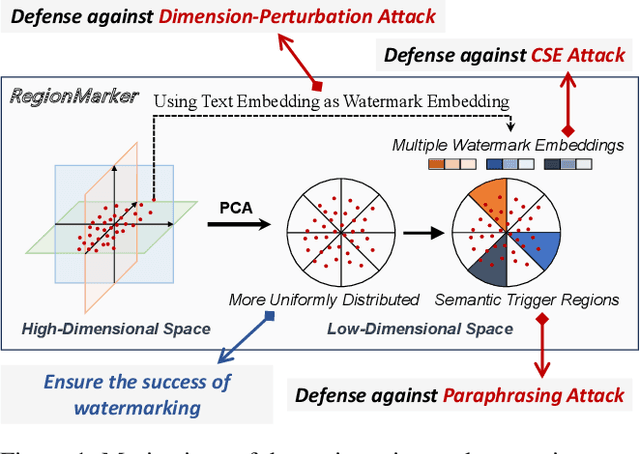
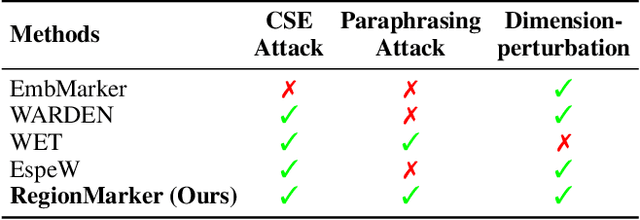
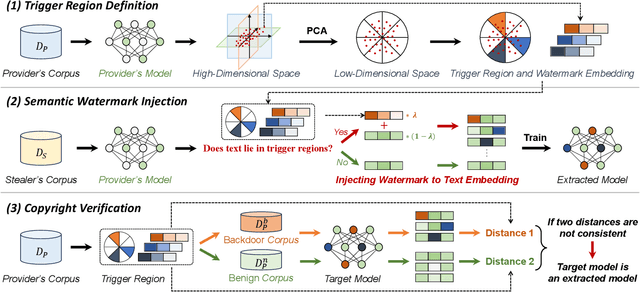
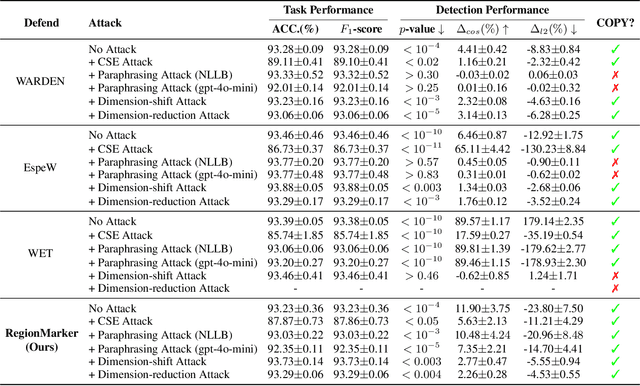
Abstract:Embedding-as-a-Service (EaaS) is an effective and convenient deployment solution for addressing various NLP tasks. Nevertheless, recent research has shown that EaaS is vulnerable to model extraction attacks, which could lead to significant economic losses for model providers. For copyright protection, existing methods inject watermark embeddings into text embeddings and use them to detect copyright infringement. However, current watermarking methods often resist only a subset of attacks and fail to provide \textit{comprehensive} protection. To this end, we present the region-triggered semantic watermarking framework called RegionMarker, which defines trigger regions within a low-dimensional space and injects watermarks into text embeddings associated with these regions. By utilizing a secret dimensionality reduction matrix to project onto this subspace and randomly selecting trigger regions, RegionMarker makes it difficult for watermark removal attacks to evade detection. Furthermore, by embedding watermarks across the entire trigger region and using the text embedding as the watermark, RegionMarker is resilient to both paraphrasing and dimension-perturbation attacks. Extensive experiments on various datasets show that RegionMarker is effective in resisting different attack methods, thereby protecting the copyright of EaaS.
Steering When Necessary: Flexible Steering Large Language Models with Backtracking
Aug 25, 2025Abstract:Large language models (LLMs) have achieved remarkable performance across many generation tasks. Nevertheless, effectively aligning them with desired behaviors remains a significant challenge. Activation steering is an effective and cost-efficient approach that directly modifies the activations of LLMs during the inference stage, aligning their responses with the desired behaviors and avoiding the high cost of fine-tuning. Existing methods typically indiscriminately intervene to all generations or rely solely on the question to determine intervention, which limits the accurate assessment of the intervention strength. To this end, we propose the Flexible Activation Steering with Backtracking (FASB) framework, which dynamically determines both the necessity and strength of intervention by tracking the internal states of the LLMs during generation, considering both the question and the generated content. Since intervening after detecting a deviation from the desired behavior is often too late, we further propose the backtracking mechanism to correct the deviated tokens and steer the LLMs toward the desired behavior. Extensive experiments on the TruthfulQA dataset and six multiple-choice datasets demonstrate that our method outperforms baselines. Our code will be released at https://github.com/gjw185/FASB.
Contrastive Prompting Enhances Sentence Embeddings in LLMs through Inference-Time Steering
May 19, 2025Abstract:Extracting sentence embeddings from large language models (LLMs) is a practical direction, as it requires neither additional data nor fine-tuning. Previous studies usually focus on prompt engineering to guide LLMs to encode the core semantic information of the sentence into the embedding of the last token. However, the last token in these methods still encodes an excess of non-essential information, such as stop words, limiting its encoding capacity. To this end, we propose a Contrastive Prompting (CP) method that introduces an extra auxiliary prompt to elicit better sentence embedding. By contrasting with the auxiliary prompt, CP can steer existing prompts to encode the core semantics of the sentence, rather than non-essential information. CP is a plug-and-play inference-time intervention method that can be combined with various prompt-based methods. Extensive experiments on Semantic Textual Similarity (STS) tasks and downstream classification tasks demonstrate that our method can improve the performance of existing prompt-based methods across different LLMs. Our code will be released at https://github.com/zifengcheng/CP.
Implicit Location-Caption Alignment via Complementary Masking for Weakly-Supervised Dense Video Captioning
Dec 17, 2024



Abstract:Weakly-Supervised Dense Video Captioning (WSDVC) aims to localize and describe all events of interest in a video without requiring annotations of event boundaries. This setting poses a great challenge in accurately locating the temporal location of event, as the relevant supervision is unavailable. Existing methods rely on explicit alignment constraints between event locations and captions, which involve complex event proposal procedures during both training and inference. To tackle this problem, we propose a novel implicit location-caption alignment paradigm by complementary masking, which simplifies the complex event proposal and localization process while maintaining effectiveness. Specifically, our model comprises two components: a dual-mode video captioning module and a mask generation module. The dual-mode video captioning module captures global event information and generates descriptive captions, while the mask generation module generates differentiable positive and negative masks for localizing the events. These masks enable the implicit alignment of event locations and captions by ensuring that captions generated from positively and negatively masked videos are complementary, thereby forming a complete video description. In this way, even under weak supervision, the event location and event caption can be aligned implicitly. Extensive experiments on the public datasets demonstrate that our method outperforms existing weakly-supervised methods and achieves competitive results compared to fully-supervised methods.
Token Prepending: A Training-Free Approach for Eliciting Better Sentence Embeddings from LLMs
Dec 16, 2024Abstract:Extracting sentence embeddings from large language models (LLMs) is a promising direction, as LLMs have demonstrated stronger semantic understanding capabilities. Previous studies typically focus on prompt engineering to elicit sentence embeddings from LLMs by prompting the model to encode sentence information into the embedding of the last token. However, LLMs are mostly decoder-only models with causal attention and the earlier tokens in the sentence cannot attend to the latter tokens, resulting in biased encoding of sentence information and cascading effects on the final decoded token. To this end, we propose a novel Token Prepending (TP) technique that prepends each layer's decoded sentence embedding to the beginning of the sentence in the next layer's input, allowing earlier tokens to attend to the complete sentence information under the causal attention mechanism. The proposed TP technique is a plug-and-play and training-free technique, which means it can be seamlessly integrated with various prompt-based sentence embedding methods and autoregressive LLMs. Extensive experiments on various Semantic Textual Similarity (STS) tasks and downstream classification tasks demonstrate that our proposed TP technique can significantly improve the performance of existing prompt-based sentence embedding methods across different LLMs, while incurring negligible additional inference cost.
Prototype based Masked Audio Model for Self-Supervised Learning of Sound Event Detection
Sep 26, 2024



Abstract:A significant challenge in sound event detection (SED) is the effective utilization of unlabeled data, given the limited availability of labeled data due to high annotation costs. Semi-supervised algorithms rely on labeled data to learn from unlabeled data, and the performance is constrained by the quality and size of the former. In this paper, we introduce the Prototype based Masked Audio Model~(PMAM) algorithm for self-supervised representation learning in SED, to better exploit unlabeled data. Specifically, semantically rich frame-level pseudo labels are constructed from a Gaussian mixture model (GMM) based prototypical distribution modeling. These pseudo labels supervise the learning of a Transformer-based masked audio model, in which binary cross-entropy loss is employed instead of the widely used InfoNCE loss, to provide independent loss contributions from different prototypes, which is important in real scenarios in which multiple labels may apply to unsupervised data frames. A final stage of fine-tuning with just a small amount of labeled data yields a very high performing SED model. On like-for-like tests using the DESED task, our method achieves a PSDS1 score of 62.5\%, surpassing current state-of-the-art models and demonstrating the superiority of the proposed technique.
LongRecipe: Recipe for Efficient Long Context Generalization in Large Language Models
Sep 04, 2024Abstract:Large language models (LLMs) face significant challenges in handling long-context tasks because of their limited effective context window size during pretraining, which restricts their ability to generalize over extended sequences. Meanwhile, extending the context window in LLMs through post-pretraining is highly resource-intensive. To address this, we introduce LongRecipe, an efficient training strategy for extending the context window of LLMs, including impactful token analysis, position index transformation, and training optimization strategies. It simulates long-sequence inputs while maintaining training efficiency and significantly improves the model's understanding of long-range dependencies. Experiments on three types of LLMs show that LongRecipe can utilize long sequences while requiring only 30% of the target context window size, and reduces computational training resource over 85% compared to full sequence training. Furthermore, LongRecipe also preserves the original LLM's capabilities in general tasks. Ultimately, we can extend the effective context window of open-source LLMs from 8k to 128k, achieving performance close to GPT-4 with just one day of dedicated training using a single GPU with 80G memory. Our code is released at https://github.com/zhiyuanhubj/LongRecipe.
USTC-KXDIGIT System Description for ASVspoof5 Challenge
Sep 03, 2024
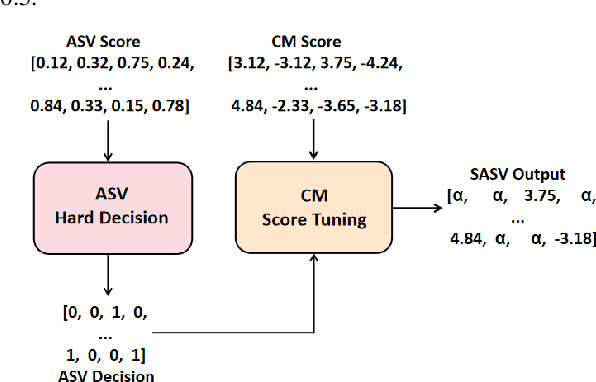
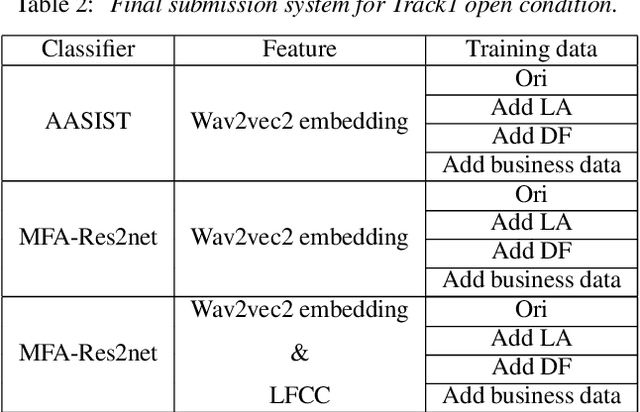
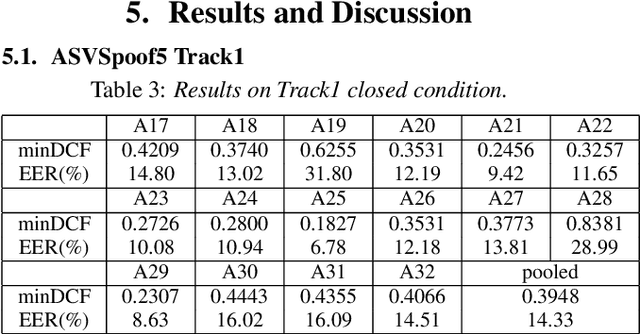
Abstract:This paper describes the USTC-KXDIGIT system submitted to the ASVspoof5 Challenge for Track 1 (speech deepfake detection) and Track 2 (spoofing-robust automatic speaker verification, SASV). Track 1 showcases a diverse range of technical qualities from potential processing algorithms and includes both open and closed conditions. For these conditions, our system consists of a cascade of a frontend feature extractor and a back-end classifier. We focus on extensive embedding engineering and enhancing the generalization of the back-end classifier model. Specifically, the embedding engineering is based on hand-crafted features and speech representations from a self-supervised model, used for closed and open conditions, respectively. To detect spoof attacks under various adversarial conditions, we trained multiple systems on an augmented training set. Additionally, we used voice conversion technology to synthesize fake audio from genuine audio in the training set to enrich the synthesis algorithms. To leverage the complementary information learned by different model architectures, we employed activation ensemble and fused scores from different systems to obtain the final decision score for spoof detection. During the evaluation phase, the proposed methods achieved 0.3948 minDCF and 14.33% EER in the close condition, and 0.0750 minDCF and 2.59% EER in the open condition, demonstrating the robustness of our submitted systems under adversarial conditions. In Track 2, we continued using the CM system from Track 1 and fused it with a CNN-based ASV system. This approach achieved 0.2814 min-aDCF in the closed condition and 0.0756 min-aDCF in the open condition, showcasing superior performance in the SASV system.
A Debiased Nearest Neighbors Framework for Multi-Label Text Classification
Aug 06, 2024Abstract:Multi-Label Text Classification (MLTC) is a practical yet challenging task that involves assigning multiple non-exclusive labels to each document. Previous studies primarily focus on capturing label correlations to assist label prediction by introducing special labeling schemes, designing specific model structures, or adding auxiliary tasks. Recently, the $k$ Nearest Neighbor ($k$NN) framework has shown promise by retrieving labeled samples as references to mine label co-occurrence information in the embedding space. However, two critical biases, namely embedding alignment bias and confidence estimation bias, are often overlooked, adversely affecting prediction performance. In this paper, we introduce a DEbiased Nearest Neighbors (DENN) framework for MLTC, specifically designed to mitigate these biases. To address embedding alignment bias, we propose a debiased contrastive learning strategy, enhancing neighbor consistency on label co-occurrence. For confidence estimation bias, we present a debiased confidence estimation strategy, improving the adaptive combination of predictions from $k$NN and inductive binary classifications. Extensive experiments conducted on four public benchmark datasets (i.e., AAPD, RCV1-V2, Amazon-531, and EUR-LEX57K) showcase the effectiveness of our proposed method. Besides, our method does not introduce any extra parameters.
Multi-Prompting Decoder Helps Better Language Understanding
Jun 10, 2024Abstract:Recent Pre-trained Language Models (PLMs) usually only provide users with the inference APIs, namely the emerging Model-as-a-Service (MaaS) setting. To adapt MaaS PLMs to downstream tasks without accessing their parameters and gradients, some existing methods focus on the output-side adaptation of PLMs, viewing the PLM as an encoder and then optimizing a task-specific decoder for decoding the output hidden states and class scores of the PLM. Despite the effectiveness of these methods, they only use a single prompt to query PLMs for decoding, leading to a heavy reliance on the quality of the adopted prompt. In this paper, we propose a simple yet effective Multi-Prompting Decoder (MPD) framework for MaaS adaptation. The core idea is to query PLMs with multiple different prompts for each sample, thereby obtaining multiple output hidden states and class scores for subsequent decoding. Such multi-prompting decoding paradigm can simultaneously mitigate reliance on the quality of a single prompt, alleviate the issue of data scarcity under the few-shot setting, and provide richer knowledge extracted from PLMs. Specifically, we propose two decoding strategies: multi-prompting decoding with optimal transport for hidden states and calibrated decoding for class scores. Extensive experiments demonstrate that our method achieves new state-of-the-art results on multiple natural language understanding datasets under the few-shot setting.
 Add to Chrome
Add to Chrome Add to Firefox
Add to Firefox Add to Edge
Add to Edge